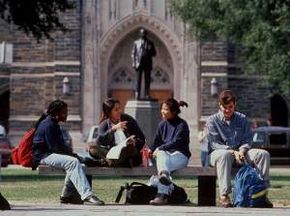Planning for college can be one of the most exciting times in a young person's life. But it can also be stressful, because there's a lot that has to happen before you're actually moving into your new dorm room. The process of selecting a college or university and applying for admission probably starts around the time you take your PSATs and concludes (happily, we hope) by April of your senior year in high school when you're notified of your status (acceptance or rejection) at the college of your choice.
Whether you are a student or a parent, the entire college admission process can seem mysterious. In this article, we'll make the admissions process much more understandable. With the help of Duke University director of undergraduate admissions Christoph Guttentag, we will use Duke University in Durham, N.C., as a real-world example of how college admission works in America.
Advertisement
Remember that every college and university -- and there are many, many schools in the United States, not to mention abroad -- has its own admissions standards and processes. So, depending upon where you apply, your experience may be different from the rather rigorous one employed by nationally ranked Duke. However, you'll definitely learn something about what can be a somewhat mysterious process -- something that can help you gain admission to the college of your choice!
Let's start at the beginning: When should you begin to think about college applications?
Thinking About the Future
The subject of college comes up with most students when they take the Preliminary Scholastic Aptitude Test, better known as the PSAT -- usually in fall of the 10th grade and no later than fall of the 11th grade. Even if you aren't thinking much about college yet, after the PSATs (which give you a good idea of how you'll do on the Scholastic Aptitude Test, or SAT), you might start to get information in the mail from colleges and universities.
How do they find you if you haven't contacted them? Colleges and universities can actually purchase mailing lists from the College Board (the organization that sponsors PSAT and SAT tests), the company that gives ACT Assessment Tests (another college admissions test) and the National Research Center for College and University Admissions (NRCCUA). Guttentag describes the lists that Duke purchases as defined mailing lists -- lists of students who did well on their PSATs and who had good high school grades. Duke uses these mailing lists as a recruitment tool, according to Guttentag. It definitely has an effect -- about 25 percent of the undergraduates accepted at Duke each year come from these defined lists.
In case you or your parents are wondering, you actually gave permission for colleges to purchase a list with your name on it if you checked a box on your PSAT agreeing to participate in a "student search" program. There are several other ways you can get on a school's mailing list -- writing to them yourself, calling them, visiting the college and meeting admissions staff or attending college fairs. It's a pretty good idea to get on mailing lists for the schools in which you're interested. You can get a feeling through regular reading of their materials for the kind of place that school might be and what it might offer to someone with your background and interests.
So how do you know if a particular school is right for you? Read on to find out.
Advertisement
